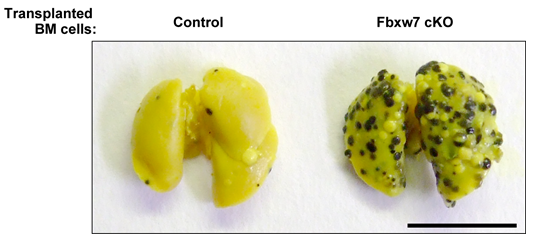|
Clarifying the role of Fbxw7 in cancer B6;129P2-Fbxw7<tm1Kei> (RBRC06393, floxed mouse)B6;129P2-Fbxw7<tm1Kin> (RBRC06394, knockout mouse)Courtesy of Keiichi Nakayama, M.D., Ph.D. Gross appearance of the lungs of wild-type mice that had been reconstituted with bone marrow (BM) cells from CAG-EGFP/Fbxw7F/F (Control) or CAG–EGFP/Mx1-Cre/Fbxw7F/F (Fbxw7 cKO) mice and injected with pIpC and mouse B16F10 melanoma cells (2.0 × 105). After 2 weeks, the animals were killed and the lungs were removed and fixed in Bouin’s solution. Scale bar, 10 mm. |
| F-box and WD-40 domain protein 7 (Fbxw7, also known as Fbw7) is an E3 ubiquitin ligase and the component of an F-box protein of the Skp, Cullin, F-box containing complex (SCF complex). Fbxw7 targets substrate proteins including c-Myc, cyclin E, and Notch for ubiquitination and degradation. Nakayama and colleagues generated mice with Fbxw7 conditionally deleted in the T cell lineage and showed that loss of Fbxw7 resulted in c-Myc accumulation, which led to hyperproliferation of immature T cells but apoptosis of mature T cells [1, 2]. |
| Cancer-initiating cells (CICs) are quiescent cells that are required for cancer initiation and maintenance. As most anti-cancer drugs target dividing cells, CICs are resistant to such therapies, resulting in disease relapse. Using a mouse model of chronic myeloid leukemia, the group revealed that ablation of Fbxw7 in leukemia-initiating cells abrogated their quiescence via c-Myc accumulation and increased their sensitivity to anti-cancer drugs. Combination therapy with Fbxw7 ablation and anti-cancer drugs was effective for leukemia-initiating cell depletion in mice [3, 4]. A recent report focused on the host environment and revealed the suppressive role of Fbxw7 in cancer metastasis via C-C motif chemokine 2 [5], showing Fbxw7 to be a therapeutic target of many kinds of human cancer. |
| Depositor | : | Keiichi Nakayama, M.D., Ph.D. Department of Molecular and Cellular Biology Medical Institute of Bioregulation, Kyushu University |
|
| Strain name | : | B6;129P2-Fbxw7<tm1Kei> | |
| RBRC No. | : | RBRC06393 | |
| Strain name | : | B6;129P2-Fbxw7<tm1Kin> | |
| RBRC No. | : | RBRC06394 | |
| Related strains | : | B6;129P2-Fbxw7<tm2.1Kei> | |
| RBRC No. | : | RBRC06395 | |
| References | : | [1] | Tsunematsu R, Nakayama K, Oike Y, Nishiyama M, Ishida N, Hatakeyama S, Bessho Y, Kageyama R, Suda T, Nakayama KI. Mouse Fbw7/Sel-10/Cdc4 is required for notch degradation during vascular development. J Biol Chem.; 279(10):9417-23, 2004. |
| [2] | Onoyama I, Tsunematsu R, Matsumoto A, Kimura T, de Alborán IM, Nakayama K, Nakayama KI. Conditional inactivation of Fbxw7 impairs cell-cycle exit during T cell differentiation and results in lymphomatogenesis. J Exp Med.; 204(12):2875-88, 2007. | ||
| [3] | Takeishi S, Matsumoto A, Onoyama I, Naka K, Hirao A, Nakayama KI. Ablation of Fbxw7 eliminates leukemia-initiating cells by preventing quiescence. Cancer Cell; 23(3):347-61, 2013. | ||
| [4] | Reavie L, Buckley SM, Loizou E, Takeishi S, Aranda-Orgilles B, Ndiaye-Lobry D, Abdel-Wahab O, Ibrahim S, Nakayama KI, Aifantis I. Regulation of c-Myc ubiquitination controls chronic myelogenous leukemia initiation and progression. Cancer Cell; 23(3):362-75, 2013. | ||
| [5] | Yumimoto K, Akiyoshi S, Ueo H, Sagara Y, Onoyama I, Ueo H, Ohno S, Mori M, Mimori K, Nakayama KI. F-box protein FBXW7 inhibits cancer metastasis in a non-cell-autonomous manner. J Clin Invest.; in press, 2015. | ||
| January 2015 Contact: Shinya Ayabe, Ph.D. Experimental Animal Division, RIKEN BioResource Center All materials contained on this site may not be reproduced, distributed, displayed, published or broadcast without the prior permission of the owner of that content. |






